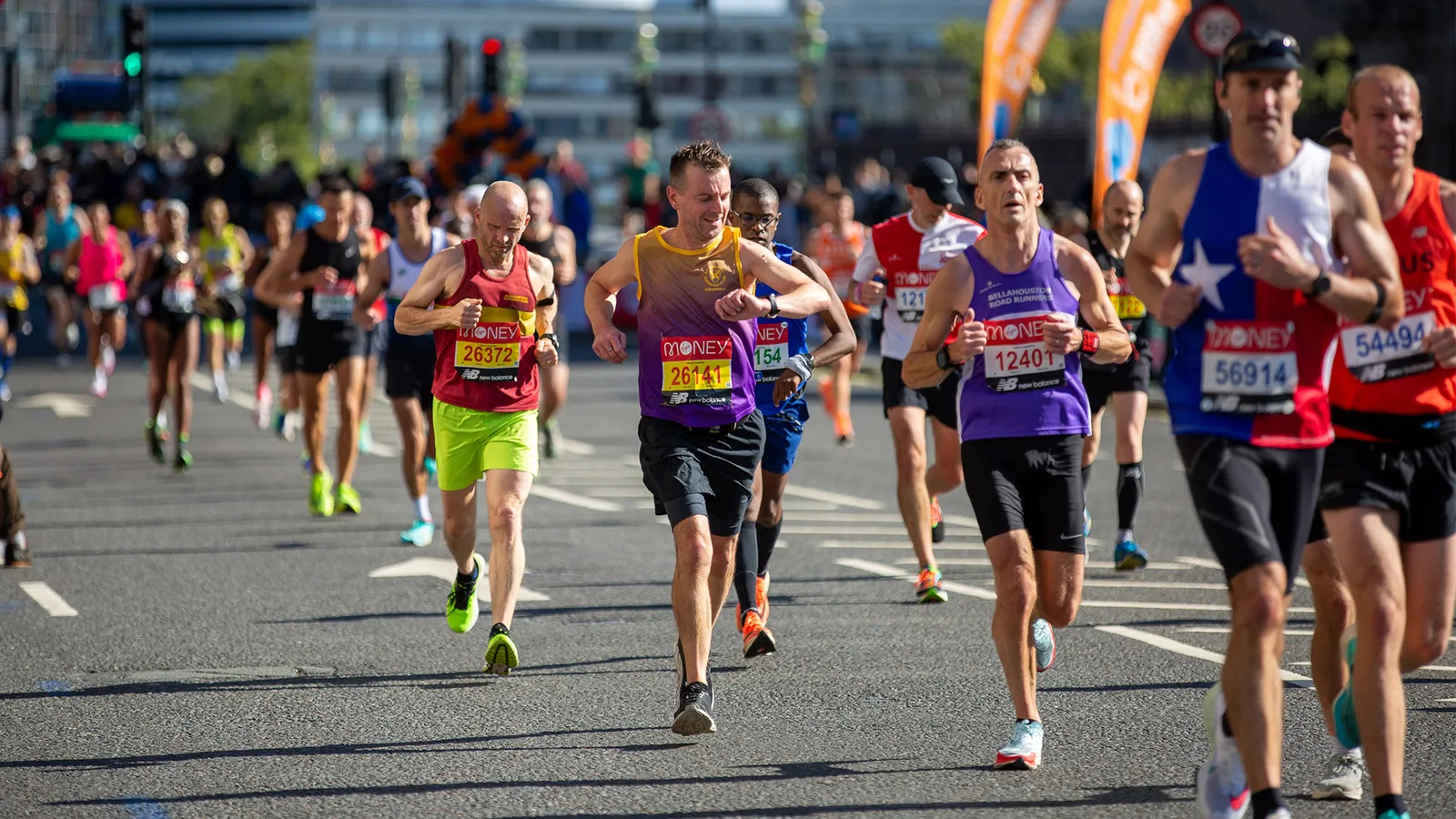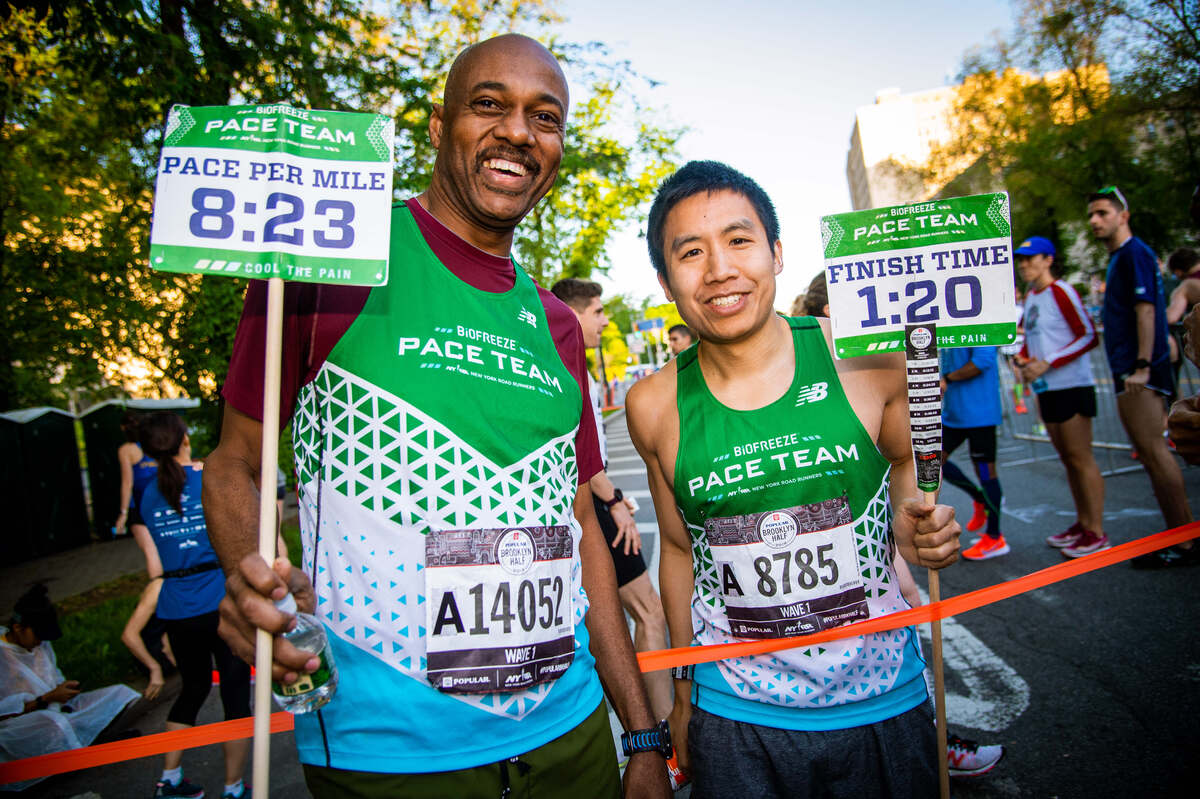

Featured
How To Pace For A Marathon
Modified: January 22, 2024
Learn the winning strategy to pace yourself for a marathon and reach your goals. Get featured tips from experienced runners and conquer your race with confidence.
Introduction
Preparing for a marathon is an exhilarating endeavor, and one of the key factors that will contribute to your success is pacing. Pacing refers to the consistent speed at which you run throughout the race, and it plays a crucial role in achieving your target time and avoiding burnout.
Setting the right pace requires careful consideration and planning. This article will guide you through the process of pacing for a marathon, from understanding your current fitness level to incorporating specific training runs that will improve your pace. We will also discuss strategies for race day pacing and how to mentally prepare yourself to maintain your desired pace from start to finish.
Whether you’re a seasoned runner looking to improve your marathon performance or a beginner preparing for your first race, mastering the art of pacing will make a significant difference in your overall experience. It will help you avoid the common mistake of starting too fast and running out of steam, allowing you to maintain a consistent and sustainable pace throughout the entire race.
In the following sections, we will explore various methods and techniques to help you pace yourself effectively in the marathon. By the end of this article, you will have a clear understanding of how to set your target pace, gauge your current fitness level, and plan your training runs to improve your pace. You will also gain insight into strategies for maintaining pace on race day and tips for adapting to unexpected pacing variations.
So, lace up your running shoes and get ready to dive into the world of marathon pacing. Let’s discover the secrets to achieving your personal best and crossing that finish line with confidence.
Setting Your Target Pace
Before you begin training for a marathon, it’s important to determine your target pace. Your target pace should be based on your desired finish time, as well as your current fitness level and past running experiences.
To set your target pace, start by researching average finish times for marathons similar to the one you plan to run. This will give you a general idea of the expected pace range. Keep in mind that marathon paces can vary depending on factors such as terrain, elevation, weather conditions, and personal fitness.
Next, consider your previous race performances, particularly in shorter distance races. Use these times as a benchmark to estimate your marathon pace. Keep in mind that marathon pace is typically slower than your 5K or 10K race pace due to the longer distance and increased endurance required.
It’s important to set a realistic and achievable target pace. Trying to run faster than you are capable of can lead to burnout and injury. On the other hand, setting a pace that is too slow may not challenge you enough or help you reach your full potential.
Once you’ve determined your target pace, practice running at that pace during your training runs. This will help your body become accustomed to the speed and build the necessary muscular endurance. Utilize a GPS watch or running app to monitor your pace during these runs and make adjustments as needed.
Remember, setting a target pace is not set in stone. As you progress in your training and gain more experience, you may find that you are capable of running at a faster pace. Be open to adjusting your target pace if you feel comfortable and confident in doing so.
Setting the right target pace is a crucial component of successful marathon pacing. It will guide your training plan and help you focus on gradually improving your speed and endurance. With a clear target in mind, you can work towards achieving your marathon goals and crossing that finish line with satisfaction and pride.
Gauging Your Current Fitness Level
Assessing your current fitness level is essential when it comes to pacing yourself for a marathon. Understanding your fitness level will help you determine the appropriate starting point for your training and allow for realistic goal-setting.
One way to gauge your fitness level is by performing a time trial. Choose a distance, such as 5 kilometers or 10 kilometers, and run it at your maximum effort. Note your finish time and use it as a reference point. This will give you an indication of your current speed and endurance.
Another method is to monitor your heart rate during various levels of exertion. By measuring your heart rate at a submaximal effort, such as a steady run or a tempo run, you can get an idea of your cardiovascular fitness. A lower heart rate at a given pace indicates better aerobic conditioning.
Additionally, considering your recent training volume and consistency can provide insights into your current fitness level. Have you been consistently running and gradually increasing your mileage? Have you been incorporating different types of runs, such as long runs and speed workouts? Reflecting on these factors will give you a sense of your overall fitness.
Furthermore, if you have recently completed any races or running events, your race times can provide valuable information about your fitness level. Compare your race results to previous performances or to age-group benchmarks. This will help you gauge whether you’re maintaining, improving, or potentially regressing in your running ability.
Remember, fitness levels can vary throughout the year due to factors such as injury, illness, or other life commitments. It’s important to assess your current fitness level honestly and without judgment. By understanding where you currently stand, you can make informed decisions about your training and pacing strategy.
Keep in mind that fitness is not solely about pace and speed. It’s also about overall health and well-being. Make sure to listen to your body, prioritize rest and recovery, and consult with a healthcare professional if you have any concerns or underlying health conditions.
Gauging your current fitness level is an important step in the marathon pacing process. By understanding where you are starting from, you can tailor your training plan to meet your specific needs and set realistic goals. Embrace your current fitness level as a starting point and trust the process as you work towards improving and accomplishing your marathon goals.
Training Runs to Improve Your Pace
Improving your pace for a marathon requires structured training runs that are specifically designed to target speed and endurance. By incorporating these runs into your training plan, you can gradually build your fitness level and improve your ability to sustain a faster pace over the course of the race.
One type of training run that can help improve your pace is the interval workout. Interval training involves alternating between periods of high-intensity effort and recovery. For example, you might run at a fast pace for a set distance or time, followed by a slower recovery pace. This helps improve your aerobic capacity, speed, and overall running efficiency.
Another effective training run is the tempo run. Tempo runs involve running at a comfortably hard pace for an extended period. The goal is to maintain a pace that is challenging but sustainable. Tempo runs help improve your lactate threshold, allowing you to maintain a faster pace for a longer period without accumulating fatigue.
Long runs are also crucial for pace improvement. Long runs are typically done once a week and involve running at a slower, more relaxed pace over a longer distance. While these runs may not directly target speed, they are essential for building endurance, mental toughness, and overall running economy. As your endurance improves, you’ll be able to maintain a faster pace for longer durations.
Hill repeats are another valuable training run to improve your pace. Incorporating hill repeats into your training helps build strength, power, and speed. Find a hill with a moderate incline and run uphill at a challenging effort for a set distance or time. Jog or walk downhill for recovery before repeating. Hill repeats not only improve your leg strength but also teach you how to maintain good form and stride efficiency when running on flat terrain.
Including a variety of training runs in your marathon preparation will not only improve your pace but also make your training more interesting and enjoyable. Aim to incorporate interval workouts, tempo runs, long runs, and hill repeats into your weekly training schedule while allowing adequate time for rest and recovery.
Remember, consistency is key. Be patient with your progress and gradually increase the intensity and duration of your training runs over time. By consistently challenging yourself and pushing the boundaries of your comfort zone, you’ll see improvements in your pace and overall fitness level.
Training runs tailored to improve your pace are essential for marathon preparation. The combination of interval workouts, tempo runs, long runs, and hill repeats will help you develop the necessary speed, endurance, and mental stamina to maintain your target pace and achieve your marathon goals.
Incorporating Interval Training
Interval training is a highly effective method for improving your pace and overall running performance. By incorporating interval training into your marathon training plan, you can enhance your speed, endurance, and anaerobic capacity.
Interval training involves alternating between high-intensity efforts and recovery periods. The high-intensity efforts are typically done at a faster pace than your usual easy or long run pace. These efforts challenge your body and force it to work at a higher level of intensity, ultimately leading to improvements in speed and cardiovascular fitness.
There are various ways to incorporate interval training into your marathon training routine. One common method is to perform short, fast intervals. For example, you might run at a high-intensity pace for 400 meters and then recover at an easy pace for an equal distance. Repeat this cycle for a predetermined number of repetitions.
Another interval training method is to use time-based intervals. Set a specific duration, such as 1 minute, and run at a hard effort for that duration, followed by a recovery period of equal or slightly longer duration. Repeat this sequence for several repetitions.
Additionally, you can incorporate longer intervals to target your marathon pace and build endurance. This involves running at a challenging pace for a longer period, such as 800 meters or 1 mile, followed by a recovery period of equal or slightly shorter duration. Repeating this cycle multiple times will help you adapt and improve your ability to maintain a steady pace throughout the marathon.
It’s important to remember that interval training should be challenging but manageable. Listen to your body and adjust the intensity and duration of your intervals based on your fitness level and progress. As you become more comfortable with interval training, you can increase the number of repetitions, the distance, or the intensity to continually challenge yourself.
Incorporating interval training into your marathon training plan should be done strategically and progressively. Start with one interval training session per week and gradually increase the frequency as your fitness level improves. Ensure that you allow enough time for recovery between interval sessions to avoid overtraining and reduce the risk of injury.
Interval training not only improves your speed and endurance but also provides a mental challenge. It teaches you to push through discomfort and maintain focus during intense efforts, which can be valuable during the difficult stages of a marathon.
By incorporating interval training into your marathon training, you’ll improve your pace, build your aerobic capacity, and develop the mental toughness needed to maintain your target pace on race day. Embrace the challenge, embrace the intensity, and enjoy the satisfaction of seeing your pace improve as you progress in your training.
Tempo Runs for Marathon Pacing
Tempo runs are a key component of marathon training that can greatly enhance your ability to maintain a challenging yet sustainable pace. By incorporating tempo runs into your training routine, you can improve your lactate threshold, increase your running economy, and gain confidence in maintaining a faster pace over a longer distance.
Tempo runs are typically performed at a comfortably hard pace, also known as your “threshold pace.” This is the pace at which you are running just below the point where lactic acid begins to accumulate in your muscles at a faster rate than your body can clear it away. This threshold pace is typically around 80-85% of your maximum effort.
The length and intensity of tempo runs can vary based on your fitness level and training goals. An example of a tempo run could be running at your threshold pace for a continuous 20 minutes or breaking it down into intervals of 10 minutes with a short recovery jog in between.
Tempo runs should feel challenging but manageable. You should be able to maintain a consistent pace throughout the run without feeling completely exhausted or out of breath. As you progress in your training, you can gradually increase the duration or intensity of your tempo runs to continue pushing your limits.
The benefits of tempo runs extend beyond improving your pace. They also help improve your mental toughness and teach you to maintain focus and concentration when running at a challenging effort. Tempo runs simulate the physical and mental demands of marathon pacing, helping you develop the necessary stamina and resilience to stay on track during the race.
When incorporating tempo runs into your marathon training plan, it’s important to schedule them strategically. Ideally, include one tempo run per week, spaced out from other key workouts to allow for sufficient recovery. Avoid doing tempo runs on consecutive days to prevent overtraining and reduce the risk of injury.
Additionally, consider incorporating progression tempo runs into your training regimen. These involve gradually increasing your pace throughout the run. Starting at an easy pace and progressively picking up your speed allows you to develop both physical and mental resilience while getting accustomed to running faster when fatigued.
Remember to warm up properly before your tempo runs and include a cool-down period afterward to allow your body to transition gradually from the higher intensity effort. Prioritize proper nutrition, hydration, and adequate rest to support your tempo run performance and recovery.
Tempo runs are a valuable training tool for marathon pacing. By regularly incorporating these runs into your training plan, you’ll improve your lactate threshold, enhance your pacing ability, and build the mental strength necessary to maintain a challenging pace throughout the marathon. Embrace the discomfort, stay focused, and reap the rewards of your dedicated training.
Long Runs to Build Endurance
Long runs are a fundamental component of marathon training that plays a crucial role in building the endurance necessary to maintain your target pace over the 26.2-mile distance. These runs not only increase your physical stamina but also help develop mental toughness and confidence in your ability to conquer the challenges of the marathon.
Long runs are typically done once a week and involve running at a slower, more relaxed pace over a longer distance than your regular training runs. The purpose of the long run is to gradually increase your mileage, allowing your body to adapt and become more efficient at utilizing fat as fuel and conserving glycogen stores.
The distance of your long runs will depend on your experience, fitness level, and training plan. Beginners may start with a long run of around 8-10 miles and gradually increase the distance each week. More experienced runners may aim for distances closer to the full marathon distance, periodically including 20-mile runs as part of their training regimen.
During your long runs, it’s important to maintain a conversation pace, where you can comfortably hold a conversation while running. This allows you to keep the intensity lower and focus on building endurance rather than speed. Remember, the primary goal of long runs is to train your body to handle the longer duration of the marathon, not to push for a fast pace.
In addition to building physical endurance, long runs provide an opportunity to practice race-day strategies and develop mental fortitude. Use your long runs to experiment with hydration and fueling strategies, pacing techniques, and mental strategies for staying focused and motivated during the later miles of the marathon.
As you progress in your training, consider incorporating progression long runs. Start at an easy pace and gradually pick up your speed as the run progresses. This helps simulate the fatigue and mental challenges encountered in the later stages of a marathon and trains your body to maintain a steady pace when fatigued.
It’s important to approach long runs with a balanced mindset. While they are designed to build endurance, pushing yourself excessively can lead to injury or increased recovery time. Listen to your body, be mindful of any pain or signs of overexertion, and adjust your pace and distance accordingly.
Moreover, don’t underestimate the importance of proper nutrition, hydration, and recovery after your long runs. Refuel with a balanced combination of carbohydrates and protein, hydrate adequately, and prioritize rest and recovery to allow your body to adapt and benefit from the efforts invested in your long runs.
Long runs are a cornerstone of marathon training, enabling you to build the necessary endurance for marathon pacing. Embrace the opportunity to explore new routes, discover your mental strength, and lay the foundation for a successful marathon performance. Consistent, well-executed long runs will not only physically prepare you for the race but also instill a sense of confidence and accomplishment as you approach the start line.
Race Day Strategies and Pacing
Race day is the culmination of weeks or months of dedicated training, and having a well-thought-out race day strategy is essential for a successful marathon performance. Effective pacing throughout the race is crucial to ensure you don’t burn out too quickly or finish with energy left in the tank. Here are some race day strategies and pacing tips to help you achieve your marathon goals.
Start conservatively: It’s easy to get caught up in the excitement and adrenaline at the beginning of the race, but starting too fast can lead to fatigue and a potential blow-up later on. Aim to start the race slightly slower than your goal pace, allowing yourself time to settle into a rhythm and find your groove.
Follow your race plan: Stick to the pacing strategy you established during your training. Trust in the hard work you put in and resist the temptation to go faster than planned, especially in the early miles. Consistency is key in marathon pacing.
Run even splits or negative splits: Ideally, aim for even splits, which means maintaining a consistent pace throughout the entire race. However, negative splits, where you gradually increase your pace in the second half of the race, can be an effective strategy as well. The key is to avoid starting too fast and save energy for the later miles.
Utilize your GPS watch or timing devices: Use your GPS watch or other timing devices to monitor your pace during the race. This will help you stay on track and make adjustments if needed. However, remember that pacing should also be based on how you feel. Don’t become overly reliant on your watch and be mindful of your body’s signals.
Break the race into segments: Mentally breaking the race into smaller segments can make the distance feel more manageable. Focus on one mile or one landmark at a time, and use these mini-goals to maintain your pace and keep yourself motivated and engaged.
Stay mentally strong: The marathon can be physically and mentally challenging, especially in the later miles. Develop mental strategies to stay focused and positive during tough moments. This can include visualization techniques, positive self-talk, or dedicating segments of the race to loved ones or causes that inspire you.
Hydrate and fuel strategically: Follow your hydration and fueling plan that you practiced during your training. Take advantage of aid stations to replenish fluids and consume electrolytes and carbohydrates regularly to maintain energy levels. However, avoid trying new foods or drinks on race day to prevent any digestive issues.
Respond to unexpected variations: Be prepared for unexpected conditions or situations during the race, such as stronger winds, sudden inclines, or unforeseen changes in weather. Stay adaptable and adjust your pace as needed while staying focused on your overall race strategy.
Remember, pacing is a delicate balance between pushing yourself to achieve your goals while maintaining a sustainable effort level. Practice your race day pacing during your long runs and tune into your body’s feedback to find your optimal pace. With proper race day strategies and pacing, you can cross the finish line with a strong and satisfying performance.
Strategies for Pacing Variations
While maintaining a consistent pace is ideal for marathon pacing, there may be situations where variations in pace are necessary or even beneficial. Here are some strategies to handle different pacing scenarios during a marathon:
1. Fast Start Strategy: In some cases, a fast start strategy may be employed, particularly in races where it may be challenging to pass slower runners or in highly competitive fields. This involves starting the race at a slightly faster pace than your goal pace for the first few miles and then settling into your intended pace. However, it’s important to exercise caution when employing this strategy to avoid burnout later in the race.
2. Negative Split Strategy: Negative splitting is when you run the second half of the race at a faster pace than the first half. This strategy requires a conservative start and gradually increasing your effort. It can be effective for runners who have a strong finishing kick or for those who prefer a more conservative approach to pacing.
3. Even Split Strategy: Running even splits means maintaining a consistent pace throughout the entire race. This strategy can be beneficial for those who want to minimize the risk of slowing down significantly in the later stages of the marathon. Even splitting requires discipline and a strong understanding of your target pace.
4. Planned Variation Strategy: In certain races, there may be sections where a variation in pace is intentional. For example, there might be a challenging uphill section where it’s reasonable to slow down slightly, followed by a downhill stretch where you can comfortably pick up the pace. Understanding the course profile and planning your pace accordingly can help optimize your performance.
5. Weather Adaptation Strategy: Weather conditions, such as heat or strong headwinds, can significantly impact your pacing. In hot conditions, adjusting your pace to account for increased effort due to heat stress is essential for avoiding dehydration and overheating. Similarly, in strong headwinds, accepting a slightly slower pace can be a more sustainable strategy to conserve energy for later miles when the wind may subside.
6. Pacing with a Group Strategy: Running with a group can provide motivation and help maintain a steady pace. However, it’s important to ensure that the group’s pace aligns with your own race plan. Communicate with your group members beforehand and have a clear understanding of the intended pacing strategy to avoid unintentional variations.
Regardless of the pacing variation strategy you choose, it’s essential to practice these scenarios during your training runs. Incorporate intervals or segments where you intentionally vary your pace to become familiar with these situations and understand how it impacts your race-day performance. This practice will help you develop the necessary adaptability and mental fortitude to handle variations and maintain control over your pacing.
Remember, every runner is unique, and finding the pacing strategy that works best for you may require some experimentation and experience. Trust in your training, stay adaptable, and be prepared to make adjustments as needed during the race to achieve your goals.
Mental Preparation for Maintaining Pace
Maintaining a consistent pace in a marathon requires not only physical training but also mental preparation. The mental aspect of pacing is crucial, as it can help you stay focused, motivated, and disciplined throughout the race. Here are some strategies for mental preparation to aid in maintaining your target pace:
1. Visualize Success: Visualize yourself running the race at your desired pace with confidence and ease. Take time during your training to imagine yourself crossing the finish line, achieving your goal time, and feeling the sense of accomplishment that comes with maintaining pace. This positive visualization can help build mental resilience and instill confidence in your abilities.
2. Break the Race into Smaller Segments: Instead of focusing on the daunting distance ahead, break the race into smaller segments or milestones. Mentally divide the marathon into manageable sections, such as miles or landmarks, and focus on reaching and maintaining your desired pace within each segment. This approach can help make the race feel more achievable and prevent overwhelming thoughts from derailing your pacing strategy.
3. Positive Self-Talk: Develop a repertoire of positive affirmations and motivational statements to use during the race. Repeat these affirmations to yourself when self-doubt or negative thoughts creep in. Replace any self-limiting or negative thoughts with empowering words that reinforce your ability to maintain pace and overcome challenges.
4. Pace Anchors: Identify visual or auditory cues that can serve as “pace anchors.” For example, you can choose a landmark on the course or a specific song on your playlist to mentally associate with your target pace. By repeatedly coming back to these cues throughout the race, you can reinforce your pacing strategy and stay on track.
5. Focus on Form and Breathing: Paying attention to your running form and breathing can help redirect your focus away from the discomfort or distractions of the race. Maintain good running posture, steady and controlled breathing, and stay mindful of efficient stride mechanics. By focusing on these technical aspects, you can maintain a steady rhythm and stay mentally engaged in your pacing.
6. Embrace Discomfort: Acknowledge that maintaining pace in a marathon will involve moments of discomfort and fatigue. Embrace these feelings as part of the challenge and remind yourself that they are temporary. Cultivating a growth mindset and a willingness to embrace discomfort can help you push through challenging moments and stay on pace.
7. Be Flexible and Adapt: Despite thorough preparation, unexpected situations or circumstances may arise during the race. Work on developing mental flexibility and adaptability to adjust your pacing strategy if necessary. This ability to adapt can help you maintain control and continue progressing towards your goal, even in the face of unforeseen challenges.
Mental preparation is just as important as physical training when it comes to maintaining pace in a marathon. Incorporate these strategies into your training routine and practice them during long runs and other key workouts. Cultivate a strong and resilient mental mindset, and you’ll be better equipped to maintain your target pace, overcome obstacles, and achieve your marathon goals.
Conclusion
Pacing is a vital component of successful marathon running, and mastering the art of pacing requires careful planning, training, and mental preparation. From setting your target pace to incorporating specific training runs, interval training, tempo runs, and long runs, every aspect of your training should be geared towards improving your ability to maintain your desired pace.
Understanding your current fitness level, gauging your progress, and adjusting your pace accordingly will play a crucial role in achieving your marathon goals. It’s important to listen to your body, be mindful of pacing variations, and adapt to unexpected challenges that may arise during the race.
Mental preparation is equally significant when it comes to pacing. Visualizing success, breaking the race into smaller segments, employing positive self-talk, and focusing on form and breathing can help you stay focused and motivated. Embracing discomfort and being flexible in your approach will ensure that you can maintain pace even under challenging circumstances.
Remember, marathon pacing is a journey that requires patience, dedication, and persistence. Trust in your training, stay disciplined, and approach the race day with confidence that you have done everything within your power to give yourself the best chance of achieving your goals.
As you lace up your shoes and embark on this marathon journey, embrace the excitement and challenges that lie ahead. With proper pacing strategies, mental strength, and a consistent training plan, you’re well on your way to crossing the finish line with confidence, pride, and a sense of accomplishment.









